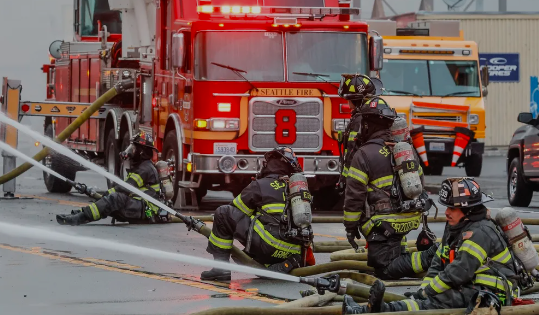Answering the Call of Duty: The Life and Challenges of Firefighters

Historical Evolution of Firefighting
1 Origins of Firefighting
The origins of firefighting can be traced back to ancient civilizations where communities organized rudimentary bucket brigades to combat fires. We explore how the concept of organized firefighting evolved over the centuries, from ancient Rome to medieval Europe.
2 The Establishment of Fire Brigades
The 17th century witnessed the formal establishment of fire brigades in major cities. We examine the evolution of firefighting equipment, from hand-pulled pumpers to the introduction of the first fire engines, marking a significant advancement in the profession.
3 Modernization and Professionalization
The 19th and 20th centuries brought about significant advancements in firefighting technology and techniques. We explore the transition from horse-drawn fire engines to motorized vehicles, the introduction of breathing apparatus, and the professionalization of firefighting as a respected and crucial public service.
The Life of a Firefighter
1 Diverse Work Environments
Firefighters operate in diverse environments, from urban settings to rural communities. We explore the challenges posed by different landscapes, including high-rise buildings, industrial areas, and wildland settings.
2 Rigorous Training and Education
The journey to becoming a firefighter involves rigorous training and education. We delve into the various training programs, certifications, and ongoing education that firefighters undergo to ensure they are prepared for the dynamic challenges they may encounter.
3 Camaraderie and Team Dynamics
The profession of firefighting thrives on teamwork and camaraderie. We explore how firefighters forge strong bonds with their colleagues, relying on trust and effective communication to navigate high-stakes situations.
Challenges Faced by Firefighters
1 Physical and Mental Demands
The physical demands of firefighting are immense, requiring strength, agility, and endurance. We also delve into the mental challenges firefighters face, including exposure to trauma, stress, and the importance of mental health support.
2 Risk of Injury and Occupational Hazards
Firefighters face a higher risk of injury due to the nature of their work. We explore the occupational hazards, including burns, respiratory issues, and the long-term health impacts associated with firefighting.
3 Emergency Response and Unpredictability
Firefighters must be prepared to respond to a wide range of emergencies, from structure fires to hazardous materials incidents. We examine how they navigate the unpredictable nature of emergency response and the importance of adaptability.
Firefighting Techniques and Equipment
1 Fire Suppression Tactics
We explore the various fire suppression tactics employed by firefighters, including the use of water, foam, and specialized extinguishing agents. The evolution of firefighting techniques, from traditional methods to cutting-edge technologies, is highlighted.
2 Protective Gear and Equipment
The personal protective gear worn by firefighters plays a crucial role in their safety. We delve into the development of modern firefighting gear, including turnout gear, helmets, and self-contained breathing apparatus (SCBA), to provide insight into the equipment that enables firefighters to operate in hazardous environments.
3 Technological Advancements
Technology has significantly impacted firefighting. We explore innovations such as thermal imaging cameras, drones, and communication systems that enhance situational awareness, improve response times, and contribute to overall operational effectiveness.
Community Engagement and Fire Prevention
1 Fire Prevention Education
Preventing fires is as crucial as responding to them. We examine how firefighters engage with communities to educate residents on fire safety, implement prevention programs, and conduct fire drills to reduce the incidence of fires.
2 Community Outreach and Public Relations
Building strong relationships with the community is an integral part of a firefighter’s role. We explore how firefighters engage in community outreach, participate in public events, and foster trust to ensure effective collaboration during emergencies.
3 Disaster Response and Community Resilience
Beyond firefighting, firefighters play a vital role in disaster response and community resilience. We examine their involvement in natural disasters, such as hurricanes and floods, showcasing their versatility in addressing a spectrum of emergencies.
The Impact of Firefighters on Society
1 Public Safety and Well-Being
The primary mission of firefighters is to protect lives and property. We explore the profound impact they have on public safety and the overall well-being of communities, emphasizing the critical role they play as first responders.
2 Role in Urban Planning and Safety
Firefighters contribute to urban planning and safety measures. We examine how their insights inform building codes, zoning regulations, and infrastructure planning to enhance overall community safety.
3 Rescue Operations and Specialized Services
Firefighters are often involved in rescue operations beyond fire suppression. We explore their participation in technical rescues, such as vehicle extrications, water rescues, and high-angle rescues, showcasing their diverse skill set.
The Future of Firefighting
1 Innovations in Firefighting Technology
The future of firefighting involves continued innovations in technology. We explore emerging technologies, including robotics, artificial intelligence, and advanced firefighting vehicles, that are poised to revolutionize firefighting practices.
2 Climate Change and Wildfire Management
Climate change poses new challenges for firefighters, particularly in managing wildfires. We examine the evolving strategies for wildfire prevention, response, and the need for international collaboration to address the global impact of changing climate patterns.
3 Professional Development and Diversity
The future of firefighting includes a focus on professional development and increasing diversity within the profession. We explore initiatives to attract a diverse workforce, enhance training programs, and ensure that firefighting reflects the demographics of the communities they serve.
Conclusion:
As we conclude this immersive journey, it is evident that firefighters are not just responders to emergencies; they are guardians of safety, resilience, and hope. The profession continues to evolve, driven by a commitment to excellence, innovation, and the timeless values of service and sacrifice. In forging ahead into the flames of tomorrow, firefighters stand ready to face the challenges of a dynamic and ever-changing world.







